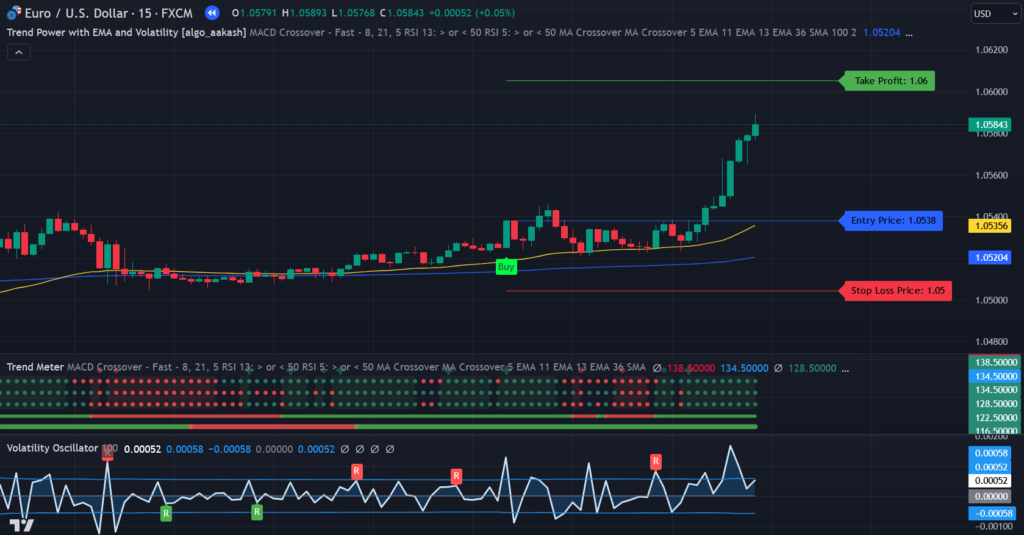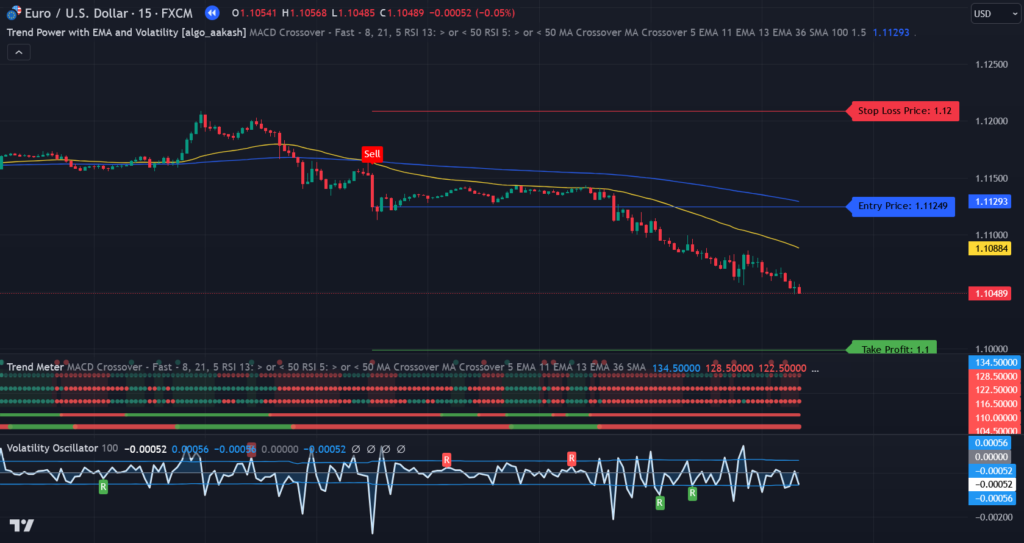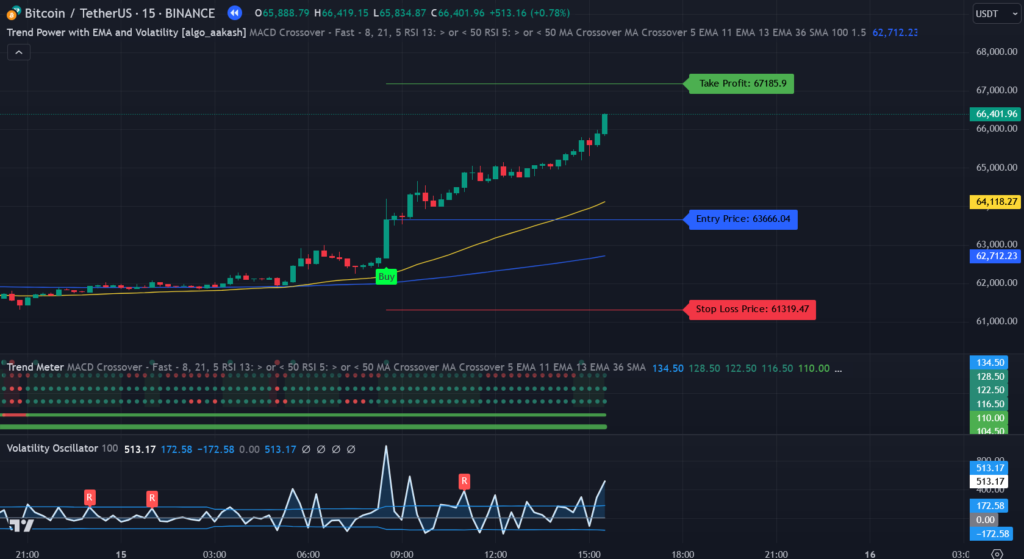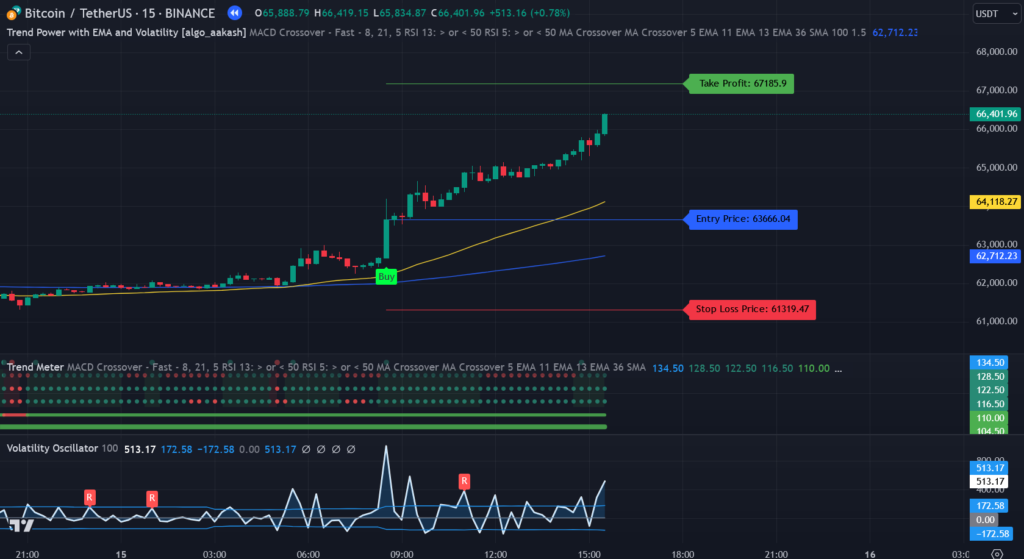🔓 Get All Tools for FREE!
- ✅ Click here to open a trading account using our referral link and start trading.
- 📅 After 7 days of active trading under our referral link, you can get access to all tools in your account.
- ⚠️ Keep trading to keep access free — if you're inactive for 7 days, your access will be removed.
- 👉 Already have an account? You can change the IB (introducing broker) to our referral link ( https://one.exnesstrack.org/a/w7syl3vnjb ) and still qualify!
In the fast-paced world of trading, traders rely on indicators to make informed decisions. TradingView, one of the most popular charting platforms, offers a vast range of indicators, each designed to simplify the analysis process. Using indicators like the Trend Meter, Volatility Oscillator, and Exponential Moving Averages (EMA) can help you navigate the markets more effectively. Let’s dive into what these indicators are, how they work on TradingView, and how you can use Pine Script to enhance your trading strategy.
What is Trend Power with EMA and Volatility Indicator?

An indicator is a statistical tool used by traders to interpret market data and make predictions. These indicators are typically mathematical calculations based on the price, volume, or open interest of a security. Traders use them to identify trends, price reversals, or other market conditions that could suggest a buy or sell opportunity.
🔓 Get All Tools for FREE!
- ✅ Click here to open a trading account using our referral link and start trading.
- 📅 After 7 days of active trading under our referral link, you can get access to all tools in your account.
- ⚠️ Keep trading to keep access free — if you're inactive for 7 days, your access will be removed.
- 👉 Already have an account? You can change the IB (introducing broker) to our referral link ( https://one.exnesstrack.org/a/w7syl3vnjb ) and still qualify!
TradingView, a leading charting platform, provides a wide variety of built-in and custom indicators. These indicators can be added to your charts to analyze price movement and assist with decision-making. Pine Script, the scripting language used on TradingView, allows you to create and customize your own indicators to better suit your trading needs.
How Trend Power with EMA and Volatility Indicator Work on TradingView?

On TradingView, indicators are applied to charts to analyze market conditions and generate trading signals. These indicators can be either custom-built using Pine Script or chosen from TradingView’s vast library of existing indicators. Once added to your chart, the indicator provides signals in real-time, which traders can use to execute trades based on certain market conditions.
Here’s a deeper look at some key indicators you can use on TradingView:
1. Trend Meter by Lij_MC
The Trend Meter indicator by Lij_MC helps traders identify the strength of a trend. It uses multiple timeframes to provide an overall picture of market direction. The indicator displays several dots and lines that change color based on the prevailing trend.
- Green Indicators: If all four dots and the two lines are green, the trend is considered bullish, indicating an uptrend.
- Red Indicators: If all four dots and the two lines are red, the trend is considered bearish, indicating a downtrend.
This color-coded system makes it easy for traders to assess market conditions at a glance, allowing for quick decision-making.
2. Volatility Oscillator by Verified
The Volatility Oscillator is an indicator designed to gauge market volatility. It is based on the concept that price movement tends to increase in times of high volatility. The oscillator generates spikes that move above and below predefined levels, signaling whether the market is experiencing high or low volatility.
- Spike Above Upper Band: When the oscillator crosses above the upper band, it signals that the market is experiencing high volatility, which often occurs before significant price movements.
- Spike Below Lower Band: Conversely, when the spike crosses below the lower band, it indicates low volatility, which suggests a period of consolidation or lack of momentum.
Traders use the Volatility Oscillator to identify potential breakouts or periods when market movement may slow down.
3. EMA 50 and EMA 200 (Exponential Moving Averages)
Exponential Moving Averages (EMAs) are a popular technical analysis tool used to smooth out price data and identify trends over a set period. The EMA 50 and EMA 200 are two of the most commonly used moving averages to assess medium and long-term trends.
- EMA 50: The 50-period EMA is used to identify shorter-term trends. When the price is above the EMA 50, it signals an uptrend, while being below it suggests a downtrend.
- EMA 200: The 200-period EMA is used to gauge longer-term trends. If the price is above the EMA 200, the overall market trend is considered bullish, and if it’s below, the trend is bearish.
When combined, the interaction between the EMA 50 and EMA 200 can provide strong confirmation of a trend. A common strategy is the “Golden Cross” (when the EMA 50 crosses above the EMA 200) for a buy signal and the “Death Cross” (when the EMA 50 crosses below the EMA 200) for a sell signal.
Setting Up Your Trading Strategy on TradingView

Now that we have an overview of the indicators, let’s discuss how you can set up a strategy on TradingView using the Trend Meter, Volatility Oscillator, and EMAs.
Buy Signal Setup:
To create a robust buy signal, you can combine the following conditions:
- Trend Meter: The Trend Meter must show all four dots and the two lines in green, indicating a strong uptrend.
- Volatility Oscillator: A spike above the upper band of the oscillator confirms high volatility, which often precedes a breakout.
- EMA 50 vs. EMA 200: The EMA 50 should be above the EMA 200, confirming the bullish trend.
- Entry Point: Place a buy entry when all the above conditions align, signaling a strong uptrend with high volatility.
Sell Signal Setup:
For a sell signal, look for the following conditions:
- Trend Meter: The Trend Meter shows all dots and lines in red, indicating a strong downtrend.
- Volatility Oscillator: A spike below the lower band suggests low volatility, which often signals the end of a trend or a potential reversal.
- EMA 50 vs. EMA 200: The EMA 50 should be below the EMA 200, confirming the bearish trend.
- Entry Point: Place a sell entry when these conditions align, indicating a strong downtrend with low volatility.
Take Profit (TP) Setup:
Take Profit levels can be set using the following methods:
- Support/Resistance Zones: Identify key levels of support and resistance, and set your TP at these points.
- Volatility Oscillator: Use the oscillator to identify when price momentum begins to weaken, signaling a potential reversal and a good point to exit.
By combining these indicators, traders can create a solid trading strategy that provides clear buy and sell signals, along with well-defined TP levels.
Using Pine Script for Customization
While TradingView provides a vast library of indicators, Pine Script allows traders to create their own custom indicators. This scripting language lets you automate your strategies, backtest them, and even optimize them for better performance.
For instance, you could create a custom strategy that automatically triggers buy or sell orders when the Trend Meter, Volatility Oscillator, and EMAs align. Pine Script also enables you to fine-tune your indicators and make adjustments as needed to suit different market conditions.
Conclusion
Using indicators like the Trend Meter, Volatility Oscillator, and EMAs on TradingView can help traders make more informed decisions. By understanding how each of these indicators works and how to combine them effectively, you can develop a strategy that minimizes risk and maximizes potential returns. Pine Script adds a layer of customization, allowing you to tailor your trading strategy to your specific needs. With the right setup and a well-defined strategy, you can harness the full potential of TradingView and Pine Script for more successful trading.
Pinescript of Trend Power with EMA and Volatility Indicator

Contact us at +91 7620658346 to unlock this indicator. We offer expert services in custom algorithm development for TradingView, MT4/MT5, and trading bots.
Stay updated—follow @algo_aakash on Instagram, YouTube, and Twitter.
Disclaimer
The information in this article and any associated indicators is intended for educational purposes only. Trading in financial markets carries significant risk, and profits are not guaranteed. Trend Power with EMA and Volatility Indicator, which may not accurately predict future market movements. Users should perform their own research, evaluate their risk tolerance, and consult a licensed financial advisor before making any trading decisions. The author and developer of this indicator are not liable for any losses resulting from its use. Please trade responsibly.
If you don’t have a TradingView account yet, click here to create one. Once your account is set up, use the link below to access this indicator.
0 Comments